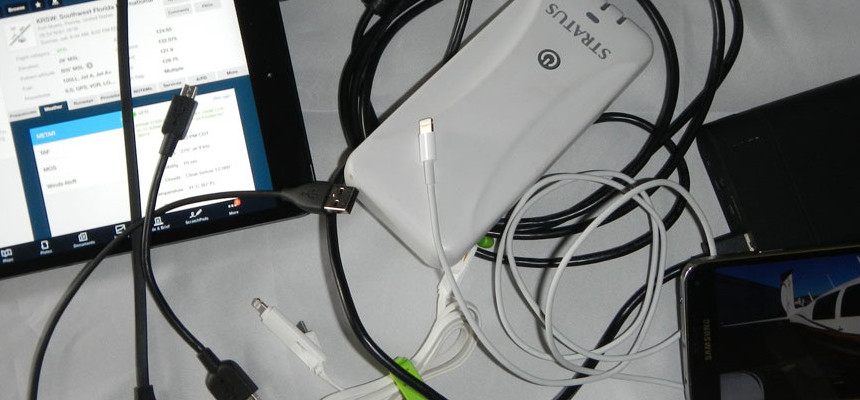If you’re planning to camp at AirVenture, either with your plane in General or Vintage aircraft camping( or in camp Scholler if you are not flying in) then you will probably have questions on how to charge the countless electronic goodies that will be coming with you. Fortunately there are a number of options. As pilots who typically, but not always, fly into AirVenture, here are the solutions we see most often.
- Go light and use the power charging stations at the bathrooms in the campground areas:

Power ports at AirVenture
For the past several years AirVenture has done a great job providing power outlets at the bathrooms of all of the campgrounds. These outlets are on two sides of each building and offer dozens of 120V outlets that sit right above a shelf and allow you to plug in your phone or tablet using the power brick that it came with. These are exceptionally convenient and allow the trustworthy visitor to travel without anything besides the gadget and a power plug.
These do come with some concerns though. Recharging can take hours and most visitors leave their phones unattended while they shower or use the facilities. We have never heard of a theft of a gadget while we have been there, but certainly this is a risk you need to consider.
These power sockets can also quickly become occupied during prime-time so if you plan to recharge in the mornings and evenings you may need to wait for an outlet. If you bring a cheap power strip you will have several new friends the moment you arrive.
- Bring a generator:
This is a great option as AirVenture provides decent wifi, and a small generator can recharge all of your gadgets in just a few hours, giving you power and connectivity right at your tent. A good generator can also power a number of other things in your campsite to make life that much easier. We have gone this route in the past with reasonable results. In the past we used a Honda four-stroke 1Kw generator like this one:
These types of generators are the lightest and quietest around. This model weighs about 26lbs and will run all week on a gallon of gas if you’re frugal.
The drawbacks for a generator are that they make noise and several of the campsites have generator operation restrictions. Then there’s the weight of the generator and how to transport it. We have never carried one in the plane and instead elected to drain it of fuel and oil and then shipped it to AirVenture ahead of time. Other years we were fortunate enough to find a ground crew that drove and offered some storage space in the back of the minivan. Lastly, these are expensive, upwards of $1000 for a new one, though in years past you could buy one at AirVenture for $700 with a show discount. (If you plan on buying at AirVenture get there early. These sell out every year)
- Energy Buckets. A third option that we tested out last year is the concept of an Energy Bucket. There’s probably a better name for this but last year we bought a device from Goal Zero called a Yeti 150. The Yeti is a 13lb lead acid battery with a built in inverter, 12volt, and USB ports.
We coupled the Yeti 150 with a couple of solar panels, also made by Goal Zero. The 20 watts of solar power from each of the panels was enough to fully charge the Yeti during the day and then use the Yeti all night long to recharge cell phones (and notebook PC’s).
The downside to an Energy Bucket in general or the Goal Zero gear in particular is that they are heavy at 13lbs for the storage capacity and they can be expensive. The combination of the Yeti 150 and the Solar Panel were 25 lbs and $400.00. This is approaching the weight and cost of the Honda generator we took in years past for substantially less capability.
In the end, for us, the Goal Zero equipment is the best compromise of self sufficiency, weight and performance. Goal Zero offers a wide range of more robust hardware and we’ll investigate that equipment as additional options for us for this year, but if you fly into AirVenture this year (2015), come and find us, our tent will be the one with the solar panels out front and a small army of gadgets charging from them every afternoon and evening.
TL;DR:
- Use the bathroom charging stations.
- Like: minimal equipment, allows you to travel light.
- Didn’t like: might have to wait for a socket, theft risk, and inconvenient location from your campsite.
- Bring a Generator.
- Like: loads of power, convenient location.
- Didn’t Like: Expensive, and heavy at 26lbs, fuel required, and noisy. Carrying a generator in an airplane is a weight and balance issue as well as a fire risk.
- Energy buckets.
- Like: portable, quiet, purpose designed for camping.
- Didn’t like: Expensive, lower capacity than a generator.
We’ll be taking our Goal Zero equipment again this year, definitely the Yeti 150 and Solar Panels and perhaps even more GZ equipment if it’s an option.
(Full disclosure: The links of the products described above take you to our Amazon.com affiliate site. We did not accept any compensation for this review and purchased this gear with our own money. The links just help us offset the cost of this site)




